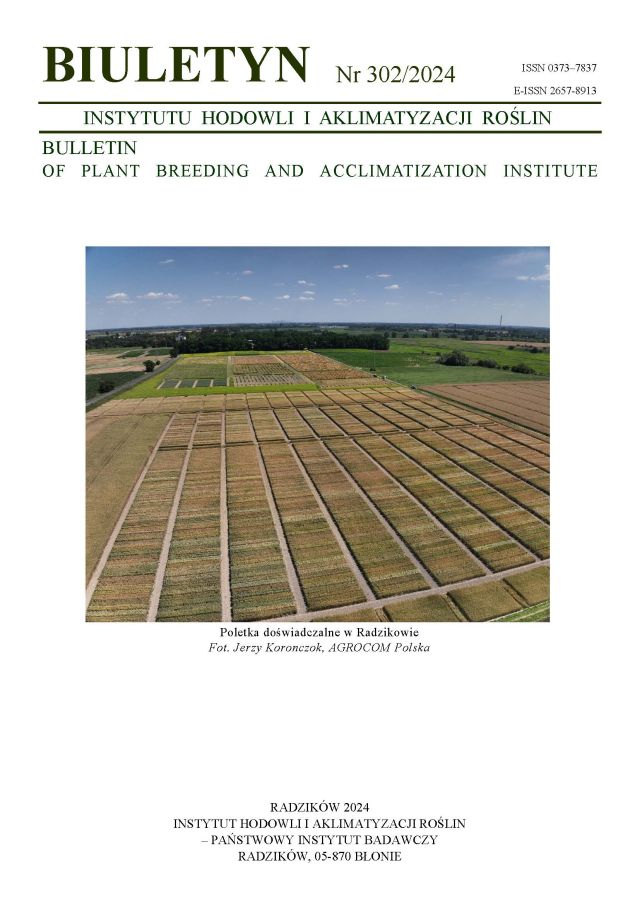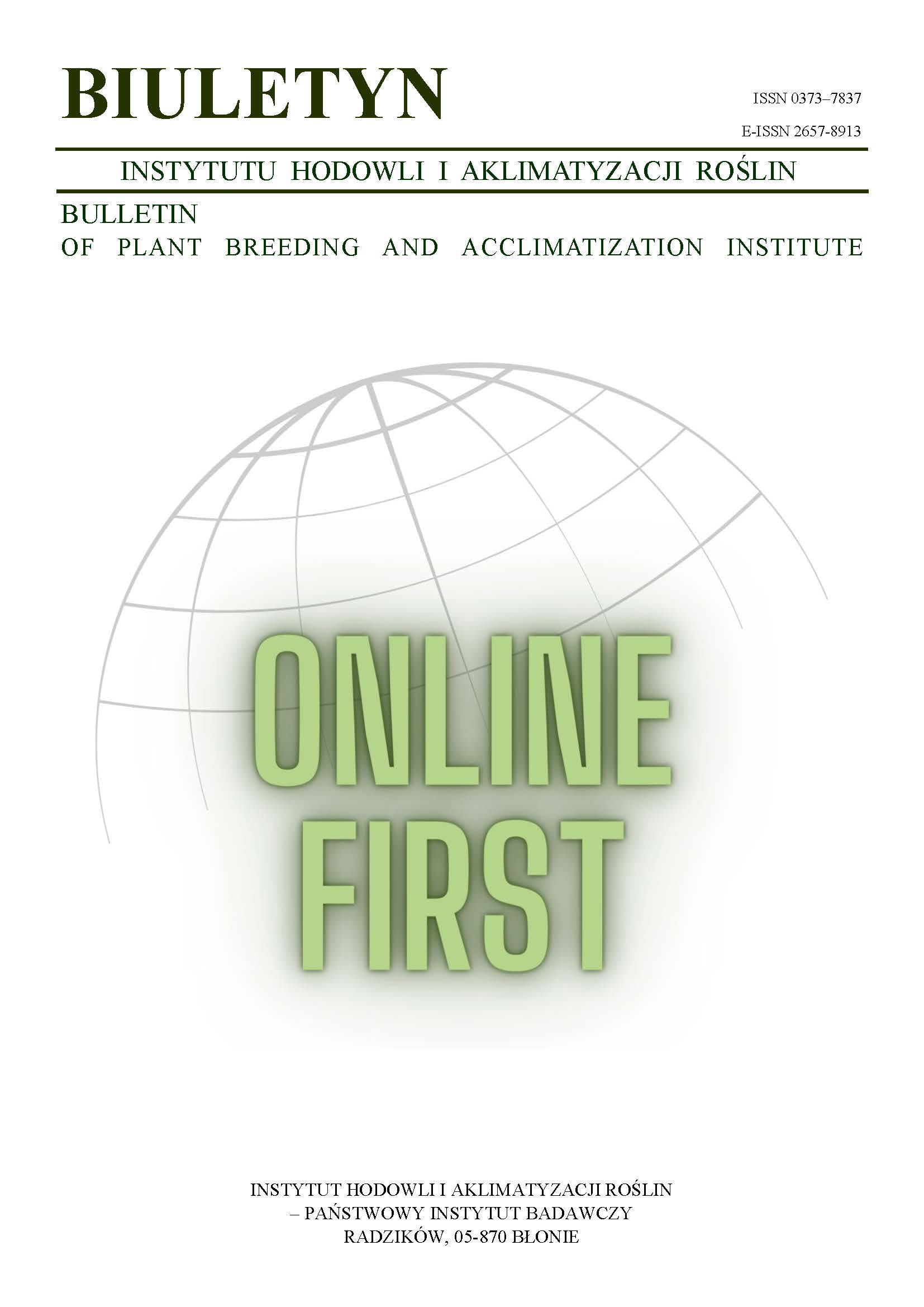Identification of SSR markers useful for construction of genetic map and mapping of angular leaf spot resistance genes in cucumber (Cucumis sativus L.)
Renata Słomnicka
skrzynka_ib-kghbr@sggw.edu.plKatedra Genetyki Hodowli i Biotechnologii Roślin, Szkoła Główna Gospodarstwa Wiejskiego w Warszawie (Poland)
Adrianna Pietluch
Katedra Genetyki Hodowli i Biotechnologii Roślin, Szkoła Główna Gospodarstwa Wiejskiego w Warszawie (Poland)
Justyna Łęczycka
Katedra Genetyki Hodowli i Biotechnologii Roślin, Szkoła Główna Gospodarstwa Wiejskiego w Warszawie (Poland)
Anna Doraczyńska
Katedra Genetyki Hodowli i Biotechnologii Roślin, Szkoła Główna Gospodarstwa Wiejskiego w Warszawie (Poland)
Aleksandra Korzeniewska
Katedra Genetyki Hodowli i Biotechnologii Roślin, Szkoła Główna Gospodarstwa Wiejskiego w Warszawie (Poland)
Helena Olczak-Woltman
Katedra Genetyki Hodowli i Biotechnologii Roślin, Szkoła Główna Gospodarstwa Wiejskiego w Warszawie (Poland)
Katarzyna Niemirowicz-Szczytt
Katedra Genetyki Hodowli i Biotechnologii Roślin, Szkoła Główna Gospodarstwa Wiejskiego w Warszawie (Poland)
Grzegorz Bartoszewski
Katedra Genetyki Hodowli i Biotechnologii Roślin, Szkoła Główna Gospodarstwa Wiejskiego w Warszawie (Poland)
Abstract
The aim of this study was identification of SSR markers useful for construction of genetic map of cucumber population that consists of 110 recombinant inbred lines (RILs). RILs population segregating for angular leaf spot (ALS) resistance was developed by crossing two inbred lines, an American line Gy14 showing tolerance for angular leaf spot and a Polish line B10, susceptible to this disease. A set of SSR markers was preliminary examined for polymorphism using bioinformatic analysis. There were 222 selected SSR markers and 160 of them were further tested on parental lines and chosen RILs. The polymorphism was confirmed for 103 (64.4%) SSR markers. Fifty two SSR markers were found to be useful for construction of genetic map of cucumber population Gy14 × B10 and further mapping of angular leaf spot resistance genes. Preliminary results suggest that SSR00398 located on chromosome 5 may be linked to angular leaf spot resistance gene.
Supporting Agencies
Keywords:
Cucumis sativus, angular leaf spot, ALS, SSR markers, Pseudomonas syringae pv. lachrymansReferences
Adhikari B. N., Savory E. A., Vaillancourt B., Childs K. L., Hamilton J. P., Day B., Buell C. R. 2012. Expression profiling of Cucumis sativus in response to infection by Pseudoperonospora cubensis. PLoS ONE 7: e34954.
Google Scholar
Benbouza H., Jacquemin J., Baudoin J., Mergeai G. 2006. Optimization of reliable, fast, cheap and sensitive silver staining method to detect SSR markers in polyacrylamide gels. Biotechnol. Agron. Soc. Environ.10: 77 — 81.
Google Scholar
Hammerschmidt R. 1999 a. PHYTOALEXINS: What have we learned after 60 years? Ann. Rev. Phytopathol. 37: 285 — 306.
Google Scholar
Hammerschmidt R. 1999 b. Induced disease resistance: how do induced plants stop pathogens? Physiol. Mol. Plant. Pathol. 55: 77 — 84.
Google Scholar
Huang S., Li R., Zhang Z., Li L., Gu X., Fan W., Lucas W. J., Wang X., Xie B., Ni P., Ren Y., Zhu H., Li J., Lin K., Jin W., Fei Z., Li G., Staub J., Kilian A., van der Vossen E. A., Wu Y., Guo J., He J., Jia Z., Ren Y., Tian G., Lu Y., Ruan J., Qian W., Wang M., Huang Q., Li B., Xuan Z., Cao J., Asan Wu Z., Zhang J., Cai Q., Bai Y., Zhao B., Han Y., Li Y., Li X., Wang S., Shi Q., Liu S., Cho W. K., Kim J. Y., Xu Y., Heller-Uszynska K., Miao H., Cheng Z., Zhang S., Wu J., Yang Y., Kang H., Li M., Liang H., Ren X., Shi Z., Wen M., Jian M., Yang H., Zhang G., Yang Z., Chen R., Liu S., Li J., Ma L., Liu H., Zhou Y., Zhao J., Fang X., Li G., Fang L., Li Y., Liu D., Zheng H., Zhang Y., Qin N., Li Z., Yang G., Yang S., Bolund L., Kristiansen K., Zheng H., Li S., Zhang X., Yang H., Wang J., Sun R., Zhang B., Jiang S., Wang J., Du Y., Li S. 2009. The genome of the cucumber, Cucumis sativus L. Nat. Genet. 41: 1275 — 1281.
Google Scholar
Jenkins S. F., Wehner T. C. 1983. A system for the measurement of foliar diseases of cucumber. Cucurbit Genet. Coop. Rep. 6: 10 — 12.
Google Scholar
Lough T. J., Lucas W. J. 2006. Integrative plant biology: role of phloem long distance macromolecular trafficking. Ann. Rev. Plant Biol. 57: 203 — 232.
Google Scholar
Malepszy S., Niemirowicz-Szczytt K. 1991. Sex determination in cucumber (Cucumis sativus) as a model system for molecular biology. Plant Sci. 80: 39 — 47.
Google Scholar
Miao H., Zhang S., Wang X., Zhang Z., Li M., Mu S., Cheng Z., Zhang R., Huang S., Xie B., Fang Z., Zhang Z., Weng Y., Gu X. 2011. A linkage map of cultivated cucumber (Cucumis sativus L.) with 248 microsatellite marker loci and seven genes for horticulturally important traits. Euphytica 182: 167 — 176.
Google Scholar
Olczak-Woltman H., Gałecka T., Korzeniewska A., Niemirowicz-Szczytt K. 2007. Odporność linii DH ogórka na bakteryjną kanciastą plamistość. Zeszyty Problemowe Postępów Nauk Rolniczych 517: 527 — 532.
Google Scholar
Olczak-Woltman H., Schollenberger M., Mądry W., Niemirowicz-Szczytt K. 2008. Evaluation of cucumber (Cucumis sativus) cultivars grown in Eastern Europe and progress in breeding for resistance to angular leaf spot (Pseudomonas syringae pv. lachrymans). Eur J. Plant Pathol. 122: 385 — 393.
Google Scholar
Olczak-Woltman H., Bartoszewski G., Mądry W., Niemirowicz-Szczytt K. 2009. Inheritance of resistance to angular leaf spot (Pseudomonas syringae pv. lachrymans) in cucumber and identification of molecular markers linked to resistance. Plant Pathol. 58: 145 — 151.
Google Scholar
Pillen K., Binder A., Kreuzkam B., Ramsay L., Waugh R., Förster J., Léon J. 2000. Mapping new EMBL-derived barley microsatellites and their use in differentiating German barley cultivars. Theor. Appl. Genet. 101: 652 — 660.
Google Scholar
Ren Y., Zhang Z., Liu J., Staub J. E., Han Y., Cheng Z., Li X., Lu J., Miao H., Kang H., Xie B., Gu X., Wang X., Du Y., Jin W., Huang S. 2009. An integrated genetic and cytogenetic map of the cucumber genome. PLoS ONE 4: e5795.
Google Scholar
Tanurdzic M., Banks J. A. 2004. Sex-determining mechanisms in land plants. Plant Cell 16 Suppl.: S61 — 71.
Google Scholar
Wan H., Yuan W., Bo K., Shen J., Pang X., Chen J. 2013. Genome-wide analysis of NBS-encoding disease resistance genes in Cucumis sativus and phylogenetic study of NBS-encoding genes in Cucurbitaceae crops. BMC Genomics 14: 109.
Google Scholar
Wóycicki R., Witkowicz J., Gawroński P., Dąbrowska J., Lomsadze A., Pawełkowicz M., Siedlecka E., Kohei Yagi, Pląder W., Seroczyńska A., Śmiech M., Gutman W., Niemirowicz-Szczytt K., Bartoszewski G., Norikazu Tagashira, Yoshikazu Hoshi, Borodovsky M., Karpiński S., Malepszy S., Przybecki Z. 2011. The genome sequence of the North-European cucumber (Cucumis sativus L.) unravels evolutionary adaptation mechanisms in plants. PLoS ONE 6: e22728.
Google Scholar
Yang L., Koo D.H., Li Y., Zhang X., Luan F., Havey M. J., Jiang J., Weng Y. 2012. Chromosome rearrangements during domestication of cucumber as revealed by high-density genetic mapping and draft genome assembly. Plant J 71: 895 — 906.
Google Scholar
Yang L., Dawei L., Yuhong L., Xingfang G., Sanwen H., Garcia-Mas J., Weng Y. 2013. A 1,681-locus consensus genetic map of cultivated cucumber including 67 NB-LRR resistance gene homolog and ten gene loci. BMC Plant Biol. 13: 53.
Google Scholar
Authors
Renata Słomnickaskrzynka_ib-kghbr@sggw.edu.pl
Katedra Genetyki Hodowli i Biotechnologii Roślin, Szkoła Główna Gospodarstwa Wiejskiego w Warszawie Poland
Authors
Adrianna PietluchKatedra Genetyki Hodowli i Biotechnologii Roślin, Szkoła Główna Gospodarstwa Wiejskiego w Warszawie Poland
Authors
Justyna ŁęczyckaKatedra Genetyki Hodowli i Biotechnologii Roślin, Szkoła Główna Gospodarstwa Wiejskiego w Warszawie Poland
Authors
Anna DoraczyńskaKatedra Genetyki Hodowli i Biotechnologii Roślin, Szkoła Główna Gospodarstwa Wiejskiego w Warszawie Poland
Authors
Aleksandra KorzeniewskaKatedra Genetyki Hodowli i Biotechnologii Roślin, Szkoła Główna Gospodarstwa Wiejskiego w Warszawie Poland
Authors
Helena Olczak-WoltmanKatedra Genetyki Hodowli i Biotechnologii Roślin, Szkoła Główna Gospodarstwa Wiejskiego w Warszawie Poland
Authors
Katarzyna Niemirowicz-SzczyttKatedra Genetyki Hodowli i Biotechnologii Roślin, Szkoła Główna Gospodarstwa Wiejskiego w Warszawie Poland
Authors
Grzegorz BartoszewskiKatedra Genetyki Hodowli i Biotechnologii Roślin, Szkoła Główna Gospodarstwa Wiejskiego w Warszawie Poland
Statistics
Abstract views: 74PDF downloads: 70
License
Copyright (c) 2015 Renata Słomnicka, Adrianna Pietluch, Justyna Łęczycka, Anna Doraczyńska, Aleksandra Korzeniewska, Helena Olczak-Woltman, Katarzyna Niemirowicz-Szczytt, Grzegorz Bartoszewski

This work is licensed under a Creative Commons Attribution-ShareAlike 4.0 International License.
Upon submitting the article, the Authors grant the Publisher a non-exclusive and free license to use the article for an indefinite period of time throughout the world in the following fields of use:
- Production and reproduction of copies of the article using a specific technique, including printing and digital technology.
- Placing on the market, lending or renting the original or copies of the article.
- Public performance, exhibition, display, reproduction, broadcasting and re-broadcasting, as well as making the article publicly available in such a way that everyone can access it at a place and time of their choice.
- Including the article in a collective work.
- Uploading an article in electronic form to electronic platforms or otherwise introducing an article in electronic form to the Internet or other network.
- Dissemination of the article in electronic form on the Internet or other network, in collective work as well as independently.
- Making the article available in an electronic version in such a way that everyone can access it at a place and time of their choice, in particular via the Internet.
Authors by sending a request for publication:
- They consent to the publication of the article in the journal,
- They agree to give the publication a DOI (Digital Object Identifier),
- They undertake to comply with the publishing house's code of ethics in accordance with the guidelines of the Committee on Publication Ethics (COPE), (http://ihar.edu.pl/biblioteka_i_wydawnictwa.php),
- They consent to the articles being made available in electronic form under the CC BY-SA 4.0 license, in open access,
- They agree to send article metadata to commercial and non-commercial journal indexing databases.
Most read articles by the same author(s)
- Grzegorz Bartoszewski, Renata Słomnicka, Helena Olczak-Woltman, Aleksandra Korzeniewska, Teresa Gałecka, Karolina Kaźmińska, Katarzyna Niemirowicz-Szczytt, Improvement of cucumber (Cucumis sativus L.) in terms of angular leaf spot resistance , Bulletin of Plant Breeding and Acclimatization Institute: No. 286 (2019): Special issue
- Karolina Kaźmińska, Aleksandra Korzeniewska, Anna Seroczyńska, Grzegorz Bartoszewski, Katarzyna Niemirowicz-Szczytt, Variability of selected quantitative traits in recombinant inbred lines of winter squash (Cucurbita maxima Duch.) , Bulletin of Plant Breeding and Acclimatization Institute: No. 276 (2015): Regular issue
- Karolina Kaźmińska, Aleksandra Korzeniewska, Katarzyna Niemirowicz-Szczytt, Grzegorz Bartoszewski, Variability and mapping of selected quantitative traits related to fruit parameters and yield of winter squash (Cucurbita maxima Duchesne) , Bulletin of Plant Breeding and Acclimatization Institute: No. 283 (2018): Special issue















